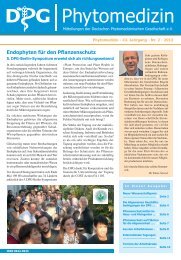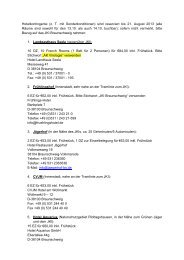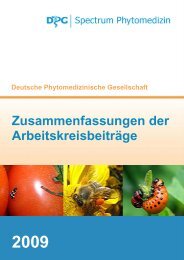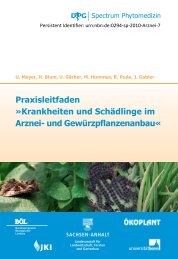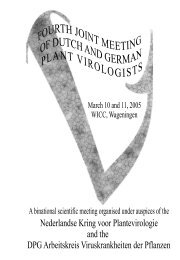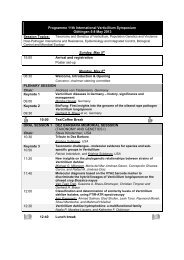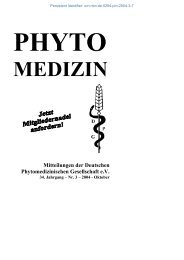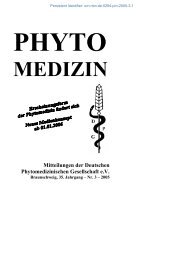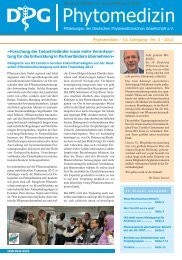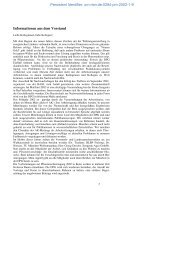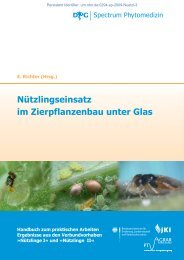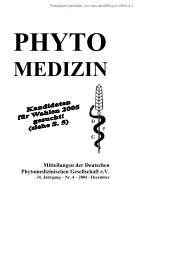Zusammenfassungen der Arbeitskreisbeiträge - Die DPG
Zusammenfassungen der Arbeitskreisbeiträge - Die DPG
Zusammenfassungen der Arbeitskreisbeiträge - Die DPG
Erfolgreiche ePaper selbst erstellen
Machen Sie aus Ihren PDF Publikationen ein blätterbares Flipbook mit unserer einzigartigen Google optimierten e-Paper Software.
demonstrated a mortality of 100% at 50, 100 and 200 EPN/larvae for both larval instars, but<br />
4 th larvae were infected faster than 2 nd instars. On the other hand, entomopathogenic<br />
nematodes are not effective against pupae of C. perspectalis. The susceptibility of C.<br />
perspectalis larvae un<strong>der</strong> more natural conditions was carried out on box trees. The<br />
application of S. carpocapsae with a pressure sprayer caused a mortality of 95%, despite the<br />
formation of feeding webs in the foliage. One experiment was applied to determine the<br />
persistence of S. carpocapsae on the foliage of box trees. After the application in the field,<br />
treated branches where sampled and fed to C. perspectalis larvae, followed by incubation in<br />
the laboratory. Even after 16 h of exposure, the resulting rate of insect mortality was 95%. An<br />
increase in the persistence by using an adhesive could not be shown. First field experiments<br />
on infested box hedges were carried out in September with S. carpocapsae and in October<br />
2011 with S. feltiae (autumn treatment). The results of the experiments indicated that feeding<br />
larvae can generally be infected whereas larvae in winter cocoons are not susceptible to<br />
nematodes.This study has shown that un<strong>der</strong> laboratory conditions S. carpocapsae is a suitable<br />
biological control agent for C. perspectalis, but the experimental conditions in field, such as<br />
the time of application and the application rates, need to be optimized.<br />
CONTROL OF THE CORN ROOTWORM WITH HETERORHABDITIS<br />
BACTERIOPHORA READY FOR USE<br />
Ralf-Udo Ehlers<br />
University Kiel, Inst. Phytopathology, Dept. Biotechnology and Biological Control, Hermann-<br />
Rodewald Str. 9, 24118 Kiel<br />
Email: ehlers@biotec.uni-kiel.de<br />
The entomopathogenic nematode Heterorhabditis bacteriophora has been tested successfully<br />
against larvae of the Corn Rootworm (Diabrotica virgifera virgifera) for the last 5 years in<br />
Hungary, Austria and Italy. When applied at a dose of 1 x 10 9 nematodes per ha the results<br />
have been comparable to those obtained with chemical seed dressing with neonicotinoides or<br />
application of granular insecticides containing the pyrethroideTefluthrin. At higher dose of 2<br />
x 10 9 the results were more stable at control between 70 and 90%. Although the differences<br />
are remote, in comparison to chemical insecticides the nematodes usually provided higher<br />
reduction of adults, whereas less root damage was recorded for chemical insecticides. The<br />
effect of nematodes is equally high, whether applied during sawing of the maize or at<br />
occurrence of the larvae approximately 6 weeks later. Different application techniques have<br />
been tried and the problems with seed dressing and granular application were discussed.<br />
Liquid applications into the drill with 200-400 liters of water have provided optimal<br />
conditions for nematode establishment and persistence until the occurrence of the larvae. With<br />
the implementation of the new EU regulation 1107/2009 of the European Parliament and of<br />
the Council of 21 October 2009 concerning the placing of plant protection products on the<br />
market and replacing Directive 91/414/EEC since 14 June 2011 the legal conditions favour<br />
biological control measures. Article 55 explicitly implies the promotion of the use of nonchemical<br />
and natural alternatives. Directive 2009/128/EC aims to achieve the sustainable use<br />
of pesticides, Article 14 lines out that “the Member States shall take all necessary measures to<br />
promote low pesticide-input pest management, giving wherever possible priority to nonchemical<br />
methods, so that professional users of pesticides switch to practices and products<br />
with the lowest risk to human health and the environment”. Biological control industry is<br />
preparing to supply the markets with the necessary amounts of the entomopathogenic<br />
nematode Heterorhabditis bacteriophora. In 2010 the first product based on this nematode<br />
was introduced.<br />
��



